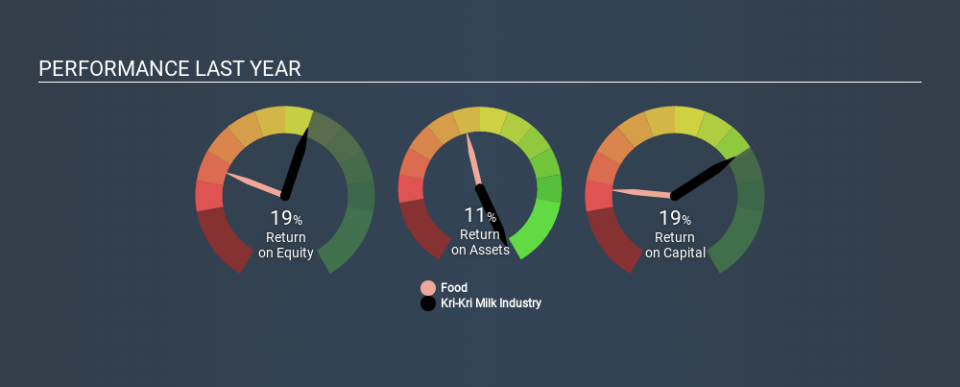Are Kri-Kri Milk Industry S.A.’s (ATH:KRI) High Returns Really That Great?

Today we'll evaluate Kri-Kri Milk Industry S.A. (ATH:KRI) to determine whether it could have potential as an investment idea. Specifically, we'll consider its Return On Capital Employed (ROCE), since that will give us an insight into how efficiently the business can generate profits from the capital it requires.
First, we'll go over how we calculate ROCE. Next, we'll compare it to others in its industry. Last but not least, we'll look at what impact its current liabilities have on its ROCE.
Return On Capital Employed (ROCE): What is it?
ROCE measures the amount of pre-tax profits a company can generate from the capital employed in its business. All else being equal, a better business will have a higher ROCE. Overall, it is a valuable metric that has its flaws. Author Edwin Whiting says to be careful when comparing the ROCE of different businesses, since 'No two businesses are exactly alike.
So, How Do We Calculate ROCE?
Analysts use this formula to calculate return on capital employed:
Return on Capital Employed = Earnings Before Interest and Tax (EBIT) ÷ (Total Assets - Current Liabilities)
Or for Kri-Kri Milk Industry:
0.19 = €16m ÷ (€110m - €25m) (Based on the trailing twelve months to September 2019.)
So, Kri-Kri Milk Industry has an ROCE of 19%.
Check out our latest analysis for Kri-Kri Milk Industry
Is Kri-Kri Milk Industry's ROCE Good?
ROCE is commonly used for comparing the performance of similar businesses. Kri-Kri Milk Industry's ROCE appears to be substantially greater than the 6.0% average in the Food industry. We consider this a positive sign, because it suggests it uses capital more efficiently than similar companies. Independently of how Kri-Kri Milk Industry compares to its industry, its ROCE in absolute terms appears decent, and the company may be worthy of closer investigation.
We can see that, Kri-Kri Milk Industry currently has an ROCE of 19% compared to its ROCE 3 years ago, which was 1.8%. This makes us wonder if the company is improving. You can see in the image below how Kri-Kri Milk Industry's ROCE compares to its industry. Click to see more on past growth.
Remember that this metric is backwards looking - it shows what has happened in the past, and does not accurately predict the future. Companies in cyclical industries can be difficult to understand using ROCE, as returns typically look high during boom times, and low during busts. ROCE is only a point-in-time measure. Since the future is so important for investors, you should check out our free report on analyst forecasts for Kri-Kri Milk Industry.
Kri-Kri Milk Industry's Current Liabilities And Their Impact On Its ROCE
Short term (or current) liabilities, are things like supplier invoices, overdrafts, or tax bills that need to be paid within 12 months. Due to the way ROCE is calculated, a high level of current liabilities makes a company look as though it has less capital employed, and thus can (sometimes unfairly) boost the ROCE. To check the impact of this, we calculate if a company has high current liabilities relative to its total assets.
Kri-Kri Milk Industry has total assets of €110m and current liabilities of €25m. As a result, its current liabilities are equal to approximately 22% of its total assets. Low current liabilities are not boosting the ROCE too much.
The Bottom Line On Kri-Kri Milk Industry's ROCE
Overall, Kri-Kri Milk Industry has a decent ROCE and could be worthy of further research. There might be better investments than Kri-Kri Milk Industry out there, but you will have to work hard to find them . These promising businesses with rapidly growing earnings might be right up your alley.
For those who like to find winning investments this free list of growing companies with recent insider purchasing, could be just the ticket.
If you spot an error that warrants correction, please contact the editor at editorial-team@simplywallst.com. This article by Simply Wall St is general in nature. It does not constitute a recommendation to buy or sell any stock, and does not take account of your objectives, or your financial situation. Simply Wall St has no position in the stocks mentioned.
We aim to bring you long-term focused research analysis driven by fundamental data. Note that our analysis may not factor in the latest price-sensitive company announcements or qualitative material. Thank you for reading.

